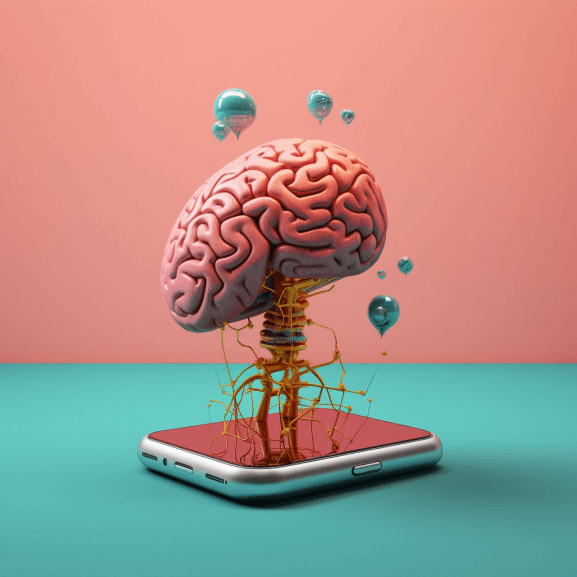Apple’s AI Revolution: A Leap into the Future
Apple’s WWDC: A Showcase of AI Advancements
Apple’s annual Worldwide Developers Conference (WWDC) proved to be an insightful event, marking a significant shift in the company’s approach to artificial intelligence (AI) and machine learning (ML). Amidst the AI advancements by industry giants like Microsoft, Google, and startups such as OpenAI, Apple showcased how its focus on on-device AI models is paying dividends.
The Autocorrect Revolution: Learning from User Texts

One notable highlight was the introduction of an enhanced iPhone autocorrect feature. Relying on ML and transformer language models, the same tech that fuels OpenAI’s ChatGPT, Apple’s autocorrect will evolve and learn from the user’s texting patterns.
Finally being very predictable is an advantage because AI will be able to predict your every text.
Example of The Autocorrect Revolution
Let’s say you’re an avid runner and you frequently text your friends about your running adventures. Often, you want to type “I ran 5k today“, but the autocorrect changes “ran” to “rain“. This becomes frustrating because the autocorrect doesn’t recognize the context of your conversation.
With Apple’s new and improved autocorrect feature, the system learns from your texting habits and understands that in the context of your texts, “ran” is a common word. Over time, the autocorrect feature will cease to change “ran” to “rain” in your running-related texts. It is learning from your patterns and adapting to them.
In addition, the autocorrect will also pick up your slangs and casual language over time. For example, if you frequently use the phrase “catch ya later“, it won’t attempt to correct it to “catch you later“. This is due to the transformer language model, which can pick up patterns in a sentence or across sentences.
Thus, Apple’s innovative approach to autocorrect, powered by ML and transformer language models, provides a more personalized and less frustrating texting experience.
Apple AI’s On-Device focus
Unlike many other tech companies that run their AI models on large servers, Apple has chosen a different route by focusing on on-device AI. In essence, on-device AI means that the AI models are run directly on the devices – like iPhones and iPads – rather than on remote servers.
The main advantage of on-device AI is its privacy-friendly nature. When an AI model runs on a device, the data it processes stays on the device and doesn’t need to be transmitted to the cloud. This eliminates the need to transfer sensitive user data over the internet, reducing the potential risks of data breaches or misuse.
For example, when using the new autocorrect feature powered by AI, your typing patterns and style are learned and processed directly on your iPhone. Apple doesn’t need to collect this data and send it to remote servers for processing. The entire learning process happens on your phone and the learned model stays on your phone, ensuring your data remains private and secure.
Moreover, on-device AI fits seamlessly with Apple’s control of its hardware stack. The company designs its own silicon chips, packing them with the AI circuits and GPUs necessary to handle complex AI tasks. This tight integration of hardware and software enables Apple to adapt quickly to changes and new techniques, providing a powerful platform for on-device AI.

Need to know more about AI?
Context-Sensitive Autocorrect and Enhanced Recognition
Apple unveiled a suite of innovative features designed to enhance the user experience:
- Improved AirPods Pro: These now automatically disable noise cancelling when the user starts a conversation, an innovation based on AI models.
- Digital Persona: A feature that projects a 3D scan of the user’s face and body, creating a virtual avatar during videoconferences through the Vision Pro headset.
- Neural Network Innovations: The introduction of new features like a function that identifies fields in PDF forms.
- Pet Recognition: A popular feature that uses ML to distinguish a user’s pet from other animals, organizing pet photos into a specific folder.

Image Segmentation and Speech Recognition
Apple has also excelled in image segmentation and speech recognition systems, with their new systemwide capability for automatic subject isolation in an image across various Apple operating systems. Improvements in voice assistants and dictation systems have allowed for effective conversion of open-ended speech into written text, crucial for devices with limited or no screens.
Conclusion
Apple’s strategic shift towards AI and ML technologies is setting new standards in how we interact with our devices. By centering on on-device AI, Apple emphasizes privacy and aims to create more intuitive, personalized user experiences. This direction marks a promising future in the convergence of AI and user-centric technologies, eagerly awaited by users and developers worldwide.
Keep reading
How to create Mortal Kombat with AI characters video
The process detailing on how to make a Mortal Kombat…
Read More




